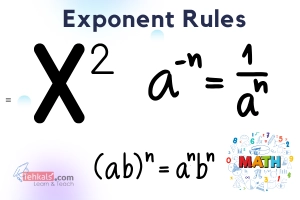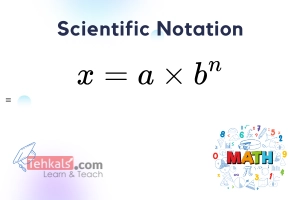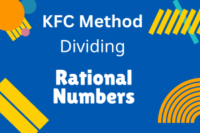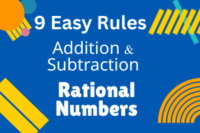Complex Number
Published: 12 Aug 2023
Numbers are the building blocks of mathematics, allowing us to quantify and understand the world around us. While real numbers like integers, fractions, and decimals are familiar to most, mathematics extends even further by introducing complex number. These numbers, often denoted as $ Z $ have applications that span various fields, from physics to engineering and mathematics to computer science.
Let us embark on a journey to understand the basics of complex number.
Define Complex Number
A number of the form $ a+bi $ where $ a $ and $ b $ are real numbers is called a complex number where $ “a” $ represents the real part of the complex number, while $ “b” $ represents the coefficient of the imaginary unit $ “i” $ known as the imaginary part.
It is typically denoted as $ Z $ and can be written in the form:
$ Z = a + bi $
In simple words:
A complex number combines a real part and an imaginary part.
Explanation of Complex Number
Complex number is an extension of the real number system, introducing an additional “imaginary” dimension. A complex number consists of two components: a real part (usually denoted as $ “a” $) and an imaginary part (usually denoted as $ “bi” $), where $ “i” $ represents the imaginary unit which is the square of $ -1 $.
Addition of Complex Numbers
The addition of complex numbers is similar to the addition of real numbers, but there is also an imaginary part. So add the real and imaginary parts separately.
Example:
$ Add \ 8+9 i \ and \ 5+2 i $
Solution:
$ 8+9 i, 5+2 i $
Let $ Z_{1}=8+9 i $
And $ Z_{2}=5+2 i $
Now
$ Z_{1}+Z_{2}=(8+9 i)+(5+2 i) $
$ Z_{1}+Z_{2}=8+9 i+5+2 i $
$ Z_{1}+Z_{2}=8+5+9 i+2 i $
$ Z_{1}+Z_{2}=13+11 i $
Subtraction of Complex Numbers
Subtract the real and imaginary parts separately.
Example:
$ Subtract \ -2+3 i \ from \ 6-3 i $
Solution:
$ -2+3 i \ from \ 6-3 i $
Let $ Z_{1}=-2+3 i $
And $ Z_{2}=6-3 i $
Now
$ Z_{2}-Z_{1}=(6-3 i)-(-2+3 i) $
$ Z_{2}-Z_{1}=6-3 i+2-3 i $
$ Z_{2}-Z_{1}=6+2-3 i-3 i $
$ Z_{2}-Z_{1}=8-6 i $
Multiplication of Complex Numbers
Multiplication of complex numbers involves distributing the terms and using the property $ i^2 = -1 $:
Example:
$ Multiply \ 1+2 i, 3-8 i $
Solution:
$ 1+2 i, 3-8 i $
Let $ Z_{1}=1+2 i $
And $ Z_{2}=3-8 i $
Now
$ Z_{1} \cdot Z_{2}=(1+2 i)(3-8 i) $
$ Z_{1} \cdot Z_{2}=1(3-8 i)+2 i(3-8 i) $
$ Z_{1} \cdot Z_{2}=3-8 i+6 i-16 i^{2} \quad As \ i^{2}=-1 $
$ Z_{1} \cdot Z_{2}=3-2 i-16(-1) $
$ Z_{1} \cdot Z_{2}=3-2 i+16 $
$ Z_{1} \cdot Z_{2}=3+16-2 i $
$ Z_{1} \cdot Z_{2}=19-2 i $
Division of Complex Numbers
Division requires the concept of the “conjugate.” For a complex number $ z = a + bi $, its conjugate is $ z^/= a – bi $.
To divide two complex numbers, multiply and divide by the conjugate of the denominator, then simplify.
Divide the first complex number by the second.
$ Z_{1}=2+i, Z_{2}=5-i $
Solution:
$ Z_{1}=2+i, Z_{2}=5-i $
$ \frac{Z_{1}}{Z_{2}}=\frac{2+i}{5-i} $
Multiply and divide by $ 5+i $
$ \frac{Z_{1}}{Z_{2}}=\frac{2+i}{5-i} \times \frac{5+i}{5+i} $
$ \frac{Z_{1}}{Z_{2}}=\frac{(2+i)(5+i)}{(5-i)(5+i)} $
$ \frac{Z_{1}}{Z_{2}}=\frac{10+2 i+5 i+i^{2}}{(5)^{2}-(i)^{2}} $
$ \frac{Z_{1}}{Z_{2}}=\frac{10+7 i+(-1)}{25-i^{2}} $
$ \frac{Z_{1}}{Z_{2}}=\frac{10+7 i-1}{25-(-1)} $
$ \frac{Z_{1}}{Z_{2}}=\frac{10-1+7 i}{25+1} $
$ \frac{Z_{1}}{Z_{2}}=\frac{9+7 i}{26} $
$ \frac{Z_{1}}{Z_{2}}=\frac{9}{26}+\frac{7}{26} i $
Complex Number – MCQs
1. A number in the form of $ a+bi $ where $ a \ and \ b $ are real number is called_______ number.O Whole
O Natural
O Real
O Complex
Show Answer
Complex
Explanation:
Definintion of Complex Number.
2. In complex number $ a+bi, \ “a” $ is called part.
O Real
O Imaginary
O Conjugate
O Transpose
Show Answer
Real
Explanation:
3. In complex number $ a+bi, \ “b” $ is called part.
O Real
O Imaginary
O Conjugate
O Transpose
Show Answer
Imaginary
Explanation:
4. The conjugate of $ a+bi $ is
O $ -a-b i $
O $ -a+b i $
O $ a-b i $
O None of these
Show Answer
$ a-b i $
Explanation:
A conjugate of a complex number is obtained by changing the sign of imaginary part.
5. $ \overline{a+bi}= $
O $ -a-b i $
O $ -a+b i $
O $ a-b i $
O None of these
Show Answer
$ a-b i $
Explanation:
The conjugate is denoted by $ \overline{a+bi}$
6. Let $ Z_1=a+b i \ and \ Z_2=c+di \ then \ Z_1=Z_2 $ if
O $ a=c $
O $ b=d $
O Both a & b
O None of these
Show Answer
Both a & b
Explanation:
$ Z_1=Z_2 $ if real parts are equal i.e. $ a=c $ and imaginary parts are equal i.e. $ b=d $.
7. $ i^2= $
O 1
O $ i $
O $ -1 $
O All of them
Show Answer
$ -1 $
Explanation:
$ i^2=-1 $
8. $ i= $
O 1
O $ i $
O $ -1 $
O $ \sqrt{-1} $
Show Answer
$ \sqrt{-1} $
Explanation:
$ i=\sqrt{-1} $
9. $ 2i(4-5i) $
O $ 8-5i $
O $ 10-8i $
O $ 10+8i $
O None of these
Show Answer
Explanation:
$ 2i(4-5i)=8i-10i^2 $
$ 2i(4-5i)=8i-10(-1) $
$ 2i(4-5i)=8i+10 $
$ 2i(4-5i)=10+8i $
10. $ (3-2i)(3+2i)= $
O $ 2+3i $
O $ 3-2i $
O $ -13 $
O 13
Show Answer
13
Explanation:
$ (3-2i)(3+2i)=3^2-(2i)^2 $
$ (3-2i)(3+2i)=9-4i^2 $
$ (3-2i)(3+2i)=9-4(-1) $
$ (3-2i)(3+2i)=9+4 $
$ (3-2i)(3+2i)=13 $
Review Exercise # 2
1. The additive inverse of $ \sqrt{5} $ isa. $ -\sqrt{5} $
b. $ \frac{1}{\sqrt{5}} $
c. $ \sqrt{-3} $
d. $ -5 $
Show Answer
$ -\sqrt{5} $
Explanation:
When the sum of two numbers is zero (0)
OR
Additive inverse is obtained by changing the sign. So, the additive inverse of
$ \sqrt{5} \ is \ -\sqrt{5} $
2. $ 2(3+4)=2 \times 3+2 \times 4 $ , here the property used is.
a. Commutative
b. Associative
c. Distributive
d. Closure
Show Answer
Distributive
Explanation:
Distributive Property is:
$ a(b+c)=ab+ac $
3. $ \sqrt{-1} \times \sqrt{-1}= $
a. 1
b. $ i $
c. $ -1 $
d. 0
Show Answer
$ -1 $
Explanation:
$ \sqrt{-1} \times \sqrt{-1} $
$ \sqrt{-1} \times \sqrt{-1}=i \times i \qquad \because \sqrt{-1}=i$
$ \sqrt{-1} \times \sqrt{-1}=i^2 $
$ \sqrt{-1} \times \sqrt{-1}=-1 $
4. Which of the following represents numbers greater than $ -3 $ but less than 6 ?
Show Answer
{x: -3 < x < 6}
Explanation:
5. If $ n=8 \ and \ 16 \times 2^m=4^{n-8} , then \ m= ? $
a. $ -4 $
b. $ -2 $
c. 0
d. 8
Show Answer
$ -4 $
Explanation:
$ 16 \times 2^m=4^{n-8} $
$ Put \ n=8 $
$ 16 \times 2^m=4^{8-8} $
$ 2^4 \times 2^m=4^0 $
$ 2^4 \times 2^m=1 $
$ 2^m=\frac{1}{2^4} $
$ 2^m=2^{-4} $
$ Thus \ m=-4 $
6. $ (i).(-i)= $
a. $ 1 $
b. $ -1 $
c. $ -i $
d. $ i $
Show Answer
1
Explanation:
$ (i).(-i)=-i^2 $
$ (i).(-i)=-(-1) $
$ (i).(-i)=-1 $
7. The multiplicative identity of real number is
a. 0
b. 1
c. $ -1 $
d. R
Show Answer
1
Explanation:
1 is called Multiplicative identity because multiplying “1” to a number does not change that number.
8. 0 is
a. a positive integer
b. a negative integer
c. neither positive nor negative
d. not an integer
Show Answer
neither positive nor negative
Explanation:
0 is the only number which is neither positive nor negative.
9. For $ i=\sqrt{-1} , if \ 3i(2+5i)=x+6i , then \ x= ? $
a. $ 5 $
b. $ -15 $
c. $ 5i $
d. $ 15i $
Show Answer
$ -15 $
Explanation:
As we have
$ 3i(2+5i)=x+6i $
$ 6i+15i^2=x+6i $
$ 15(-1)=x \qquad \because \sqrt{-1}=i $
$ -15=x $
10. $ \sqrt{0}= $
a. 0
b. 1
c. $ -1 $
d. Not defined
Show Answer
0
11. $ \sqrt{-(-9)^2}= ? $
a. $ 9 $
b. $ 9+i $
c. $ 9-i $
d. $ 9i $
Show Answer
$ 9i $
Explanation:
$ \sqrt{-(-9)^2}=\sqrt{-81} $
$ \sqrt{-(-9)^2}=\sqrt{-1 \times 81} $
$ \sqrt{-(-9)^2}=\sqrt{-1} \times \sqrt{81} $
$ \sqrt{-(-9)^2}=i \times 9 \qquad \because \sqrt{-1}=i $
$ \sqrt{-(-9)^2}=9i $






